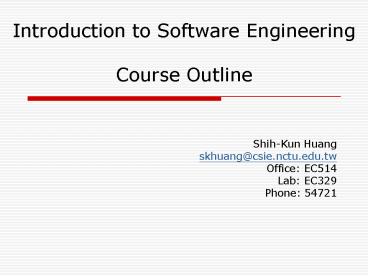Introduction to Software Engineering Course Outline - PowerPoint PPT Presentation
1 / 13
Title:
Introduction to Software Engineering Course Outline
Description:
Y2K stories. Textbook and References. Textbook: Ian Sommerville. ... Validation (what customer wants, Testing, Quality Assurance) ... – PowerPoint PPT presentation
Number of Views:211
Avg rating:3.0/5.0
Title: Introduction to Software Engineering Course Outline
1
Introduction to Software EngineeringCourse
Outline
- Shih-Kun Huang
- skhuang_at_csie.nctu.edu.tw
- Office EC514
- Lab EC329
- Phone 54721
2
Motivation
- Software Cost
- Software Quality Concerns
- Safety, Security, Robustness
- Why Outsourcing ?
- Y2K stories
3
Textbook and References
- Textbook Ian Sommerville. Software Engineering,
7th edition. Addison Wesley. 2004. ISBN
0-321-21026-3 - http//www.software-engin.com/
- References
- Roger S. Pressman. Software Engineering a
practitioners approach, 6th edition.
McGRAW-HILL. 2005. - Edward Yourdon, Decline Fall of the American
Programmer, Prentice Hall, Inc. 1993.
4
Course Outline
- Introduction (FAQs about SE)
- Software Processes
- Requirements
- Design
- Verification and Validation
- Project Management
- Other Topics
5
Software Processes
- Activities concern about Software Development
- Software Specification
- Design
- Implementation
- Validation (what customer wants, Testing, Quality
Assurance) - Software Evolution (must evolve to meeting
changing needs of customers, maintenance) - Process Models
- Waterfall model, evolutionary development
(concurrent activities), component-based software
engineering (design with reuse) - CASE tools for aiding the evolving of processes
6
Requirements
- Detailed Descriptions of what the system should
do. - Functional (service provided) and non-functional
requirements (constraints) - User Requirements (external behavior of the
system) - System Requirements (starting points for system
design)
7
Design
- Architecture Design
- Subsystem identifications
- Subsystem Control and Communication
- Output the Software Architecture
- Object-oriented Design
- Design as a set of interacting objects
- User interface Design
- Interface code constitutes the major part of
system - Judging the system from UI instead of
Functionality - External Behaviors of the system
8
Verification and Validation
- Validation Building the right product ?
- Software meets the users expectations
- Verification Building the product right ?
- Software conforms to the specification
- Software Testing
- Formal Methods
9
Project Management
- Project Scheduling
- Software Metrics
- Cost Estimation
- Quality Management
- Risk Management
- Change Management
10
Other Issues
- Software Outsourcing
- Open source Software Engineering
- Building for Trustworthy
- Component-based development
11
Grading Policy
- Mid-term(T1) and Final term exam(T2)
- Term Project (P) (4 members a group)
- Homework (H)
- G1 30 (T1), 30(T2), 30(P), 10(H)
- G2 20 (T1), 20(T2), 50(P), 10(H)
- Max(G1, G2)
12
Term Project
- Register an account in sourceforge.net or
openfoundry.org - Propose a software system to be developed (either
from scratch or the existing GPL projects) - Evaluate the project from the analysis, design,
and various documents among the processes
13
Notes
- Please ensure your correct E-mail in
cos.adm.nctu.edu.tw. - Ensure your valid login in e2.nctu.edu.tw.
















![[CS-225: Software Engineering] PowerPoint PPT Presentation](https://s3.amazonaws.com/images.powershow.com/7552154.th0.jpg?_=20160119103)














